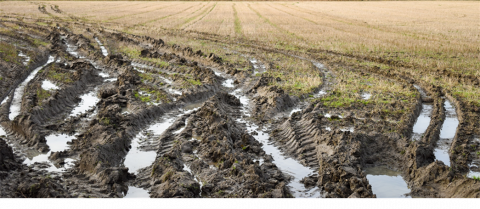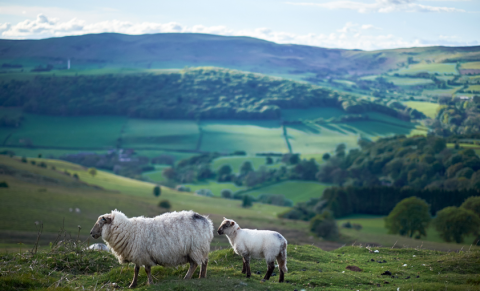16 October 2020
Dr David Cutress: IBERS, Aberystwyth University.
- The shift in agricultural practices towards environmental sustainability requires improved alternative forage options
- Periods of bare soil and topographical features such as upland hillslopes increase water run-off and associated negative environmental impacts
- Improving sustainability involves carefully considering soil health and how various systems can interact with soil management
Introduction
There is an ongoing shift in agricultural practices towards the improved provision of ‘public goods’, including, environmentally positive farming practices and improving long-term sustainability. As noted in recent agricultural legislation, grants and subsidies will be increasingly focused on farms which can implement these strategies, and those that find the best balance between these, whilst maintaining higher productivity, will likely see the most profitable returns. Potential climate change influences are already being observed in the form of erratic, more difficult to predict/model, weather patterns including severe droughts and more extreme floods. These factors combined are making arable production and livestock grazing, in already difficult areas such as the uplands, even more complex to manage. Despite the difficulties associated with managing British upland areas, these are noted as important carbon sinks, with almost a third of the UK's soil organic carbon (SOC) found in the uplands, as well as for their roles in flood mitigation as a public good. Currently, UK wide, around 41% of grazed agricultural land is used for rough grazing (split between common and sole right usage) with only 9% being considered temporary, and the remaining 50% being permanent grazing of forage over 5 years old. Compared to rough grazing, both temporary and permanent systems are amenable to being managed in more targeted ways based on farm needs. This can involve variability in grazing rotations, livestock stocking density, sward species compositions and seeding/planting strategies able to affect both the productivity of lands as well as their sustainability. Where planting strategies are considered it is well understood in research that land preparation with high soil disturbance or excessive heavy machinery use such as ploughing is environmentally detrimental. Furthermore, findings on the negative impacts of monoculture leys, including their reduced adaptability and high nutrient input requirements are adding interest to multispecies implementations and long-term perennial options. Other farm environmental adaptations have been discussed in previous technical articles and can be incorporated across all farming systems as well as upland grazing, these include; vegetation buffer strips, silvopasture, winter cover crops and increased presence of perennial crops. Forage optimisation for increased efficiency in livestock production is key to utilising available landmass to its best ability whilst reducing environmental impacts. Particularly over autumn-winter periods, alternative forage options can reduce costs and impacts associated with longer indoor housing and supplying supplementary feeds.
Soil structure and health
Soil health within agricultural systems is becoming an increasing subject of focus. Targets on sustainable use of soil supplementation (both organic and inorganic sources of N and P etc.), the finite level of resources available and a growing concern with the detrimental level of nutrient losses to the environment are all issues. Sediment transport and soil erosion are higher from hillslopes and in cultivated land in comparison to pastures and woodlands. In a recent simulation, the importance of land management changes was noted, with up to 40% reductions in sediment loss via incorporation of riparian woodland buffers. This was further improved upon converting arable fields to permanent pastures and utilising grass field margins to over 50% of cropped fields, particularly in combination with winter cover crops. Where livestock grazing is concerned, as opposed to arable systems, it is suggested there are reduced benefits of crop residue presence in returning nutrients to the soil and reducing wind and water soil erosion impacts. Whilst grazers convert forage to manure, this does not provide the same types of nutrient returns and the direct physical coverage effects of crop residues are reduced. This suggests potential benefits in considering alternatives to livestock grazing for environmental impacts. Furthermore, any system where bare or nearly bare soil is present in the winter months is far more susceptible to increased run-off damage and nutrient loss, with land preparation for winter cereal crops and coverage gaps before reseeding on grazed brassica cover crops being common examples. Where considering brassica utilisation as a grazing crop, indications suggest that fibrous-rooted cover crop species are far more beneficial to controlling soil erosion than taproot species such as stubble turnips. Interestingly, however, very little direct comparative research has been performed between different brassica and cover crop species for their environmental impacts. As such Farming Connect’s demonstration farm Dolygarn is looking at comparing different species of forages to evaluate increased fibrous root structures as well as species with regrowth potential. Their upland beef and sheep farm hopes to demonstrate reduced run-off and improved environmental impacts whilst maintaining productivity in their grazing systems. Reduced impact direct drilling is also being utilised to assist in minimising detrimental impacts on soil disturbance.
Mixed-species forages
Mixed-species forages, in an optimal system, involve several carefully selected complementary crops (generally 6 + species) which combine species for above and below-ground biomass considerations. These also consider nutrient recycling interactions and increased resilience and adaptability to changes in the environment. Adaptability has been observed to weather changes, pest impacts, disease impacts and that reduced weed-crop competitions often occur, whilst subsequently, there is an increase in the biodiversity observed within a mixed system. Environmentally, when well-designed, mixed-species systems lead to a balance of nutrient demand causing niche complementarity, this generally requires lower nutrient inputs than monoculture systems. Alongside improved nutrient utilisation research suggests mixed-species systems produce higher biomass than monocultures, though it has been noted this impact is higher in mixed leys with more than just 2 or 3 species. Incorporation of legume species such as clovers add protein and can act to fix nitrogen in the soil reducing the need for N fertiliser and improving nitrogen use efficiency in grazing stocks. This reduces the impacts associated with N on climate change, soil pollution/runoff and leaching. Legumes are commonly employed in forage seed mixes, for this reason, however, work performed at Pwllpeirian, Aberystwyth University’s uplands research platform, notes that current legume varieties lack optimisation for upland specific environmental challenges. As such plant breeding with a focus on upland productivity could play an important role in improving mixed-species successes, alongside more unique crop varieties such as bird’s-foot trefoil (Lotus corniculatus) which has been trialled. Climactic shifts and extreme weathers are likely to have increasing impacts on the future of grazing and forage management. In future targeted combinations of species may need to be considered for specific applications, for example where two crop species might normally clash due to competition under normal water availability, in drought or floods, specific species mixes can increase each other’s survival characteristics.
Permanent pasture crops
Increased use of permanent or long-term perennial crops can have several benefits to grazing areas with the added benefit of reducing annual or seasonal costs of labour, machinery use and materials in their maintenance. A key aspect to permanent pastures is the presence of constant soil coverage and improved soil anchorage over many annual systems (unless these incorporate well-managed winter cover crops). Shifts to permanent grass covers from annual winter cereals were demonstrated to account for reduced soil erosion risk in 30% of sites surveyed within high erosion risk UK farmlands. Permanent pastures have also been associated with improved levels of soil carbon and sequestration compared to more intensive systems. The main soil property changes come from reduced soil disturbances, increased organic matter input from roots and better establishment of associated rhizobacteria compared to annual crops. Most studied options for inclusion in permanent pasture systems include perennial grass species and perennial legumes consisting of 1,000’s of species worldwide with differing surface covers, root morphologies and rooting depths able to be exploited to match to individual situations and environments. Where adaptability is concerned systems such as in perennial vs seasonal forage covers have noted that whilst forage yield increased with seasonal forages, perennial systems had far lower within-year variability due to different levels of rainfall. This suggests that increasing climate uncertainty favours perennial permanent crops which are well established and less susceptible to environmental variability.
Summary
Several options exist in alternative forage systems, particularly over areas which are continuing to utilise monoculture pastures. Whilst multiple species seed mixes are becoming more common, they are often limited in their diversity to 3 or 4 species which may reduce their potential gains. Furthermore, soil health and stability are increasingly noted as a core element in achieving increased environmental benefits such as increased carbon sequestration and reduce leaching and water-course pollution. A noted methodology to increase soil health is the inclusion of long-term perennial cropping systems towards the establishment of extensive undisturbed below ground rooting infrastructures. Both increased species coverage and permanent options, as well as combinations of the two, have high potential in improving environmental impacts of all farming systems including upland areas. Provided optimisations are performed with alternative strategies on a like-for-like basis to traditional systems (similar soils, hillslope conditions, nutrient inputs etc) and are tailored to the specific environment, it is suggested they can demonstrate equal if not improved impacts on the overall productivity of both crops and grazing livestock. Furthermore, diversification away from livestock grazing may require more consideration by upland farmers as new grant schemes provide improved incentives. These could involve the use of marginal land to produce biofuels or provide public goods including; open space access, biodiversity, soil protection/improvement and water or air quality.




